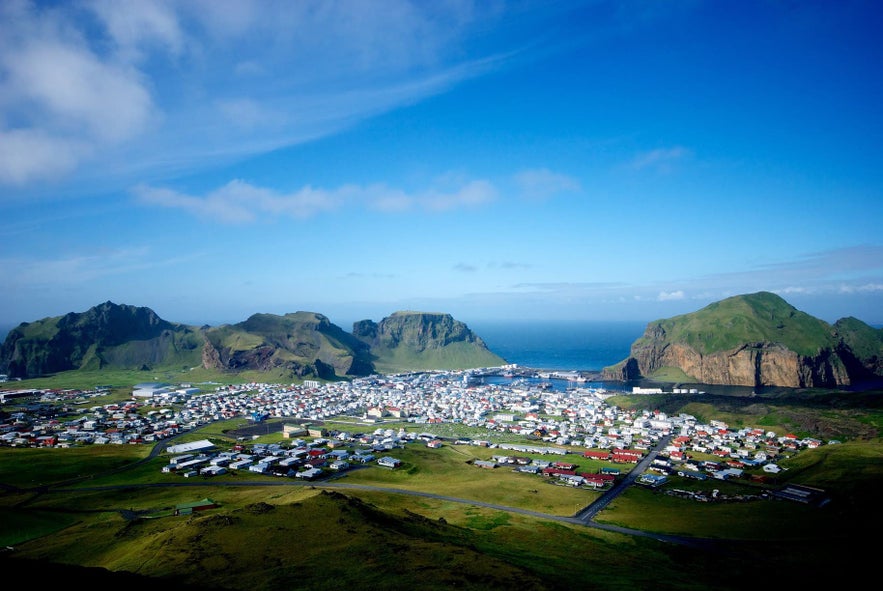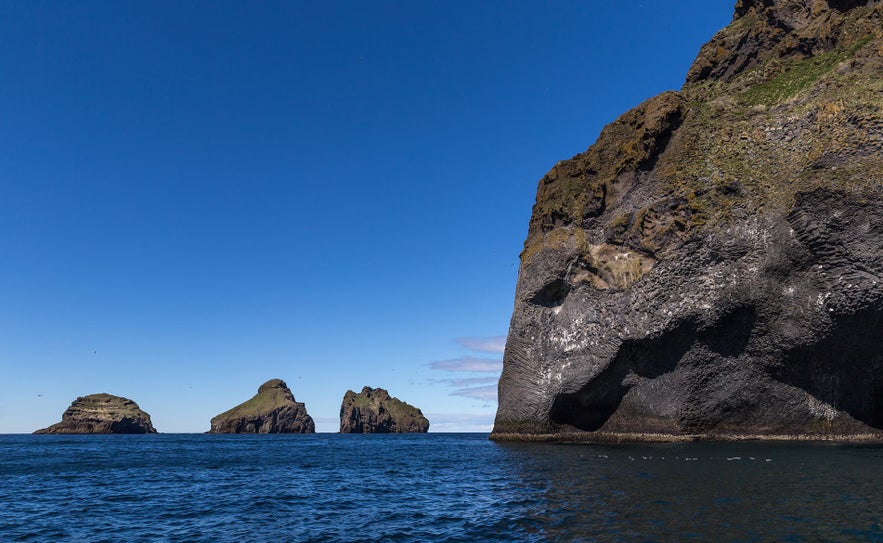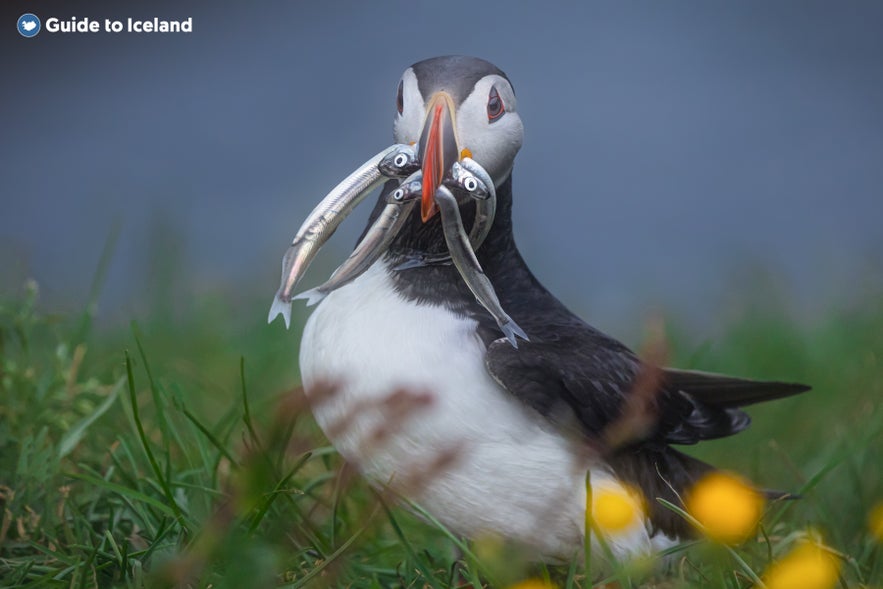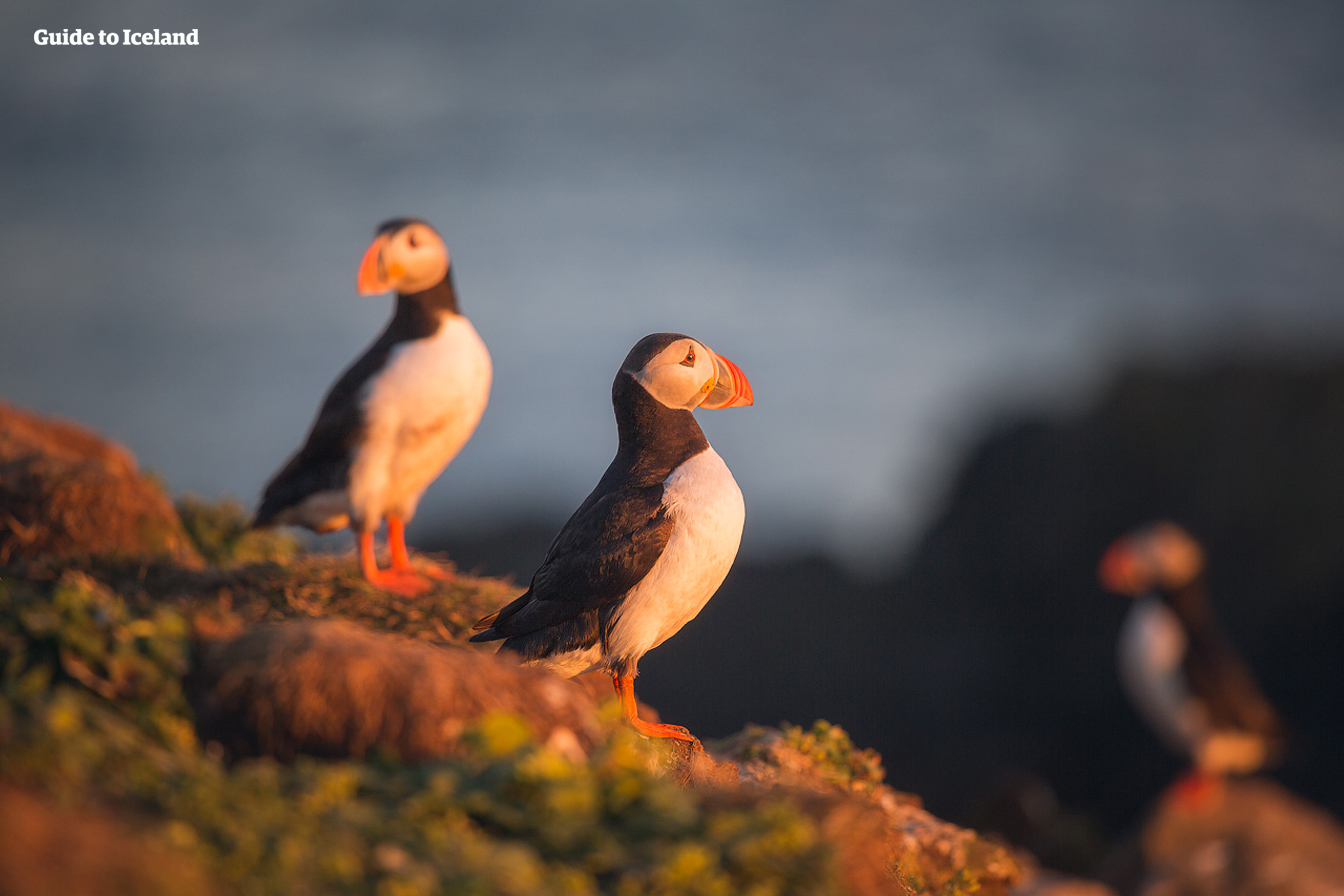
Les îles Westman, ou Vestmannaeyjar, sont un archipel de 15 îles et 30 rochers au large de la côte sud de l'Islande. Outre leur incroyable beauté naturelle, ces îles abritent la plus grande population de macareux moines nichant en été et leur propre histoire est fascinante.
Explorez ces îles lors d'une visite des îles Westman ou d'un forfait vacances.
Pourquoi Notre Contenu Mérite Votre Confiance
Guide to Iceland est la plateforme de voyage la plus fiable en Islande, aidant chaque année des millions de visiteurs. Tous nos contenus sont rédigés et vérifiés par des experts locaux qui connaissent parfaitement le pays.Comptez sur nous pour des conseils de voyage précis, actuels et fiables.
L’Histoire des îles Westman
L'histoire des îles Westman est aussi sombre qu'intrigante, commençant au tout début de l'histoire de l'Islande, avec la première famille à s'y installer.
La première personne réputée pour s'être installée de façon permanente en Islande était un homme appelé Ingólfr Arnarson (bien qu'il convient de noter qu'il n'est pas venu seul ; il était accompagné de sa femme Hallveig Fróðadóttr et de plusieurs esclaves). Son demi-frère l'a rejoint dans le pays, quelques années plus tard, mais a trouvé la mort aux mains de deux de ses propres hommes capturés.
Ces esclaves ont tenté de fuir et de se cacher, pour échapper à la vengeance d'Arnarson. Ils ont atteint les îles Westman, mais malheureusement, ont été trouvés par le « père de l'Islande » et tués en représailles.
Depuis, les îles ont été nommées d'après ces hommes ; c'étaient des esclaves irlandais, et à l'époque, les Irlandais étaient appelés « Westmen », car on pensait que l'Irlande était la terre la plus à l'ouest avant la découverte de l'Islande.
Ce début brutal donnerait un aperçu des événements ultérieurs qui se produiraient et façonneraient l'archipel.
L'île la plus grande, Heimaey, a été colonisée au début de l'ère, et ses habitants vivaient de la fertilité des océans, des macareux et des œufs. La vie était difficile mais gérable jusqu'à ce qu'une terrible tragédie se produise en 1627.
À l'apogée de l'Empire ottoman, ce sont les pirates barbaresques d'Alger qui régnaient sur les mers, et ils ont réussi à se frayer un chemin vers cette petite île. Ils en ont pris le contrôle pendant trois jours, avant de repartir chez eux avec 237 esclaves.
La grande majorité d'entre eux ont passé le reste de leur vie en captivité, bien que certains aient été rachetés en 1638.
Les épreuves du voyage et de leur captivité ont été relatées dans un roman par un prêtre qui a réussi à s'échapper en 1628.
Malheureusement, ce n'était pas la dernière calamité majeure à frapper les îles.

Au 20e siècle, il semblait que les îles Westman avaient surmonté leurs difficultés, s'étaient modernisées et étaient mieux reliées au continent. Cela, cependant, devait être annulé en 1973.
À 1 h 55, le 20 janvier, une fissure s'est ouverte au milieu de la ville d'Heimaey, et le volcan Eldfell jusqu'alors inconnu a commencé à entrer en éruption violemment. En quelques heures, il avait traversé l'île, projetant des fontaines de lave en l'air et déversant des gaz nocifs dans l'atmosphère.
Incroyablement, cependant, personne n'a été tué. Il y avait un plan d'urgence pour une telle situation, et heureusement, les tempêtes des jours précédents signifiaient que toute la flotte de pêche était amarrée dans le port. Toute la population de l'île a été mise en sécurité.
Cela ne veut pas dire, cependant, que le travail était terminé. 5 300 personnes avaient leur maison dans la ville, et les autorités islandaises étaient désespérées de faire ce qu'elles pouvaient pour aider à les protéger. À l'époque, les États-Unis avaient une base de l'OTAN dans le pays, et leur aide a été sollicitée.
En pompant de l'eau de mer sur les grands fronts de lave, il était possible de refroidir la roche en fusion, de la ralentir et de changer sa direction.
Cette technique innovante, jamais utilisée auparavant, a été particulièrement efficace lorsqu'il s'agissait de protéger le port. Il semblait à un moment donné que l'éruption aurait pu le fermer complètement, détruisant ainsi l'économie de l'île. Cependant, en pulvérisant la lave, le port a été davantage enfermé et amélioré.
Lorsque l'éruption s'est terminée, l'île s'est lentement repeuplée à environ 85 % de sa population précédente ; environ un cinquième des bâtiments ont été détruits.
La ville, cependant, avait maintenant une longue étendue de terre nouvelle sur laquelle construire une piste d'atterrissage et un volcan en son centre pour attirer les visiteurs. Depuis lors, les îles Westman se sont rétablies en tant que destination touristique populaire.

Les îles Westman Aujourd'hui
Aujourd'hui, les îles Westman attirent des milliers de visiteurs depuis des années pour diverses raisons. Beaucoup souhaitent visiter le cratère d'Eldborg et en apprendre davantage sur l'éruption au musée Eldheimar. D'autres viennent pour des opportunités naturelles incroyables.
Tout d'abord, il y a des possibilités d'observation des macareux. Dix millions de macareux nichent en Islande entre mai et septembre, et un plus grand nombre d'entre eux viennent aux îles Westman que partout ailleurs.
Ils nichent dans les falaises, les crevasses et les pitons rocheux et peuvent être facilement vus en se déplaçant à pied ou en bateau. Vers la fin de la saison, de nombreux macareux sont confondus par les lumières de la ville alors qu'ils essaient de se frayer un chemin vers l'océan et finissent dans les rues ; c'est donc une tradition locale parmi les enfants de les ramasser et de les jeter à la mer.
Certains jeunes entrepreneurs les ramassaient même et les « vendaient » aux touristes pour les relâcher.
Les macareux ne sont qu'une des trente espèces environ qui nichent sur les îles, mais ils sont de loin les plus nombreux.

Les îles Westman offrent également certaines des meilleures possibilités d'observation des baleines du pays, avec des rorquals communs, des petits rorquals et des baleines à bosse souvent observés en été et des orques tout au long de l'année.
Heimaey abrite le premier sanctuaire de bélugas au monde. En échange d'un don à l'organisme de bienfaisance, les visiteurs peuvent rencontrer Little White et Little Grey dans leurs maisons de la baie de Klettsvik.
Choses à Faire Dans les îles Westman
Voici une liste d'idées de choses à faire dans les îles Westman.
-
Visitez l'île Heimaey : C'est la plus grande île du groupe et elle abrite la majeure partie de la population locale. Elle offre de nombreuses activités de plein air, notamment la randonnée, l'observation des oiseaux et des excursions en bateau.
-
Visitez le volcan Eldfell : Ce volcan est entré en éruption en 1973, entraînant l'évacuation de la population de l'île. Aujourd'hui, vous pouvez faire une randonnée jusqu'au sommet d'Eldfell pour voir le cratère et profiter des vues spectaculaires du paysage environnant.
-
Explorez Storhofdi : C'est la pointe la plus méridionale de l'île et c'est un endroit populaire pour l'observation des oiseaux. Vous pouvez voir des macareux, des guillemots et d'autres oiseaux marins nicher sur les falaises.
-
Visitez le musée Eldheimar : Ce musée raconte l'histoire de l'éruption volcanique de 1973 et son impact sur la communauté locale. Il présente des expositions sur l'histoire de l'île et de l'éruption, ainsi qu'un théâtre projetant un film sur l'éruption.
-
Faites une excursion en bateau : Plusieurs compagnies proposent des excursions en bateau autour des îles, ce qui est un excellent moyen de voir la côte accidentée et la variété de la faune de la région, notamment les baleines, les dauphins et les oiseaux marins.
-
Visitez l'aquarium de Sæheimar : Cet aquarium abrite une grande variété d'animaux marins, dont des macareux, des phoques et diverses espèces de poissons. Il présente également des expositions sur l'histoire de la pêche dans la région et sur l'environnement marin local.
-
Visitez la vallée de Herjólfsdalur : Cette vallée est située à l'ouest de l'île et abrite plusieurs sentiers de randonnée. Elle abrite également une ancienne ferme et une église historique.
-
Savourez la cuisine locale : Les îles Westman sont connues pour leurs fruits de mer frais, en particulier la langoustine et la morue. Il y a plusieurs restaurants sur l'île qui proposent des plats locaux ainsi que de la cuisine islandaise traditionnelle.
Se Rendre aux îles Westman
Le ferry Herjolfur se rend aux îles Westman depuis la ville de Landeyjahöfn, sur la côte sud de l'Islande, pour le trajet le plus court. Dans de mauvaises conditions, notamment entre novembre et mars, il peut partir de Þorlákshöfn. Il est également possible de voler vers les îles depuis Reykjavík Domestic Airport.









